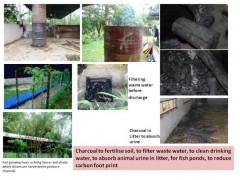Jul 27, 2009
Charcoal for Sustainability
We produce our own charcoal for multiple use at the farm: to bury carbon as part of the requirement for responsible animal husbandry, to use it to absorb urine and reduce ammonia in litter, to act as a filter in aquaculture, to clean waste water before discharging into rivers, to use as fertiliser for our fruits and vegetables, and to use as a more efficient source of fuel.
We plant fast growing trees such as acacia mangium and gliricidia septium as a renewal source of wood for charcoal production. The fast growing trees are planted where ever we have chickens, even right next to the coops or rebans.
In the fields, they not only convert CO2 to carbon, but also absorb nutrients from the chicken dung.
In this way, we try to reduce our carbon footprint, which should be a required part (and parcel) of the process of raising animals for food.
Click on the picture below for enlarged view:
09:45 Posted in Sustainable Farming | Permalink | Comments (1) | Tags: biochar, retort, sustainable farming









Comments
HS, thanks for this post - could you provide an update on what your experiences have been with charcoal two years later now? With the discovery of the Amazonian terra preta, charcoal has been lauded as a the key to rich, sustainable tropical agriculture and it'd be interesting to know how effective you've found it.
Also, do you add it fresh to the soil? Do you pound it? Do you find you need to dig it into the soil or does it work as as part of a top dressing/mulch?
Thank you!
Posted by: Brian | Apr 26, 2011
The comments are closed.